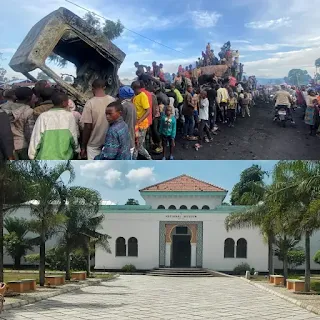Thousands of people are fleeing violence in eastern Democratic Republic of Congo as fighting intensifies between the Congolese army and the M23 armed group.
The fighters reportedly surrounded the strategic town of Sake on Wednesday, a crucial stopover before reaching Goma, the capital of North Kivu. Occupying Sake would deal a logistical blow to Congolese soldiers.
The Congolese army and United Nations peacekeeping forces are struggling to contain the M23 advance. And as fighting continues, thousands of those who fled Sake have arrived in Bulengo, about 10 kilometers west of Goma.
“The situation in Sake is very bad, with violent fighting between soldiers and M23 rebels. They attacked with heavy weapons and bombs fell on the town that’s why we are leaving for Goma,” said Justin Musau, a displaced person from Sake.
Another displaced person, Henriette Muyume, said: “We are fleeing the fighting between rebels and soldiers. We don’t know where we can go but we can’t survive in this situation, it’s too much for us.”
Clashes between rebels, armed forces and self-defense groups supporting them have recently intensified, forcing entire communities in Masisi and Rutshuru territories to flee to areas perceived as safer on the outskirts of Goma.
Tanzania: a museum village in Dar es Salaam preserves ancestral culture
The Village Museum, located in Dar Es Salaam, Tanzania, is an open-air museum dedicated to preserving the indigenous culture and architecture of the country's diverse ethnic groups.
With more than 45 dwellings representing the 120 Tanzanian tribes , this museum's primary purpose is to allow future generations to reconnect with their origins.
_"It is of the utmost importance that individuals visit African sites, immerse themselves in dance and become familiar with the culture. It is essential to understand the different typologies of huts, to understand the reasons for their construction," _underlines Tolu Adesholu, Nigerian tour operator.
Visitors have the opportunity to explore reconstructed villages , each reflecting the lifestyle of a distinct ethnic group in Tanzania . These homes serve as both historical artifacts and living manifestations of the skills and knowledge passed down from generation to generation.
"We have a variety of tribes represented in the village museum. Visitors can observe various types of habitats. Among them, the Thembe houses, rectangular in configuration, topped with thatched roofs and mud at the top. Msonge houses are also thatched, while Banda houses have a gable roof and are typically located along the coast,” said Wolbert Lema, senior curator of the museum.
Museum curators point out that young Africans are increasingly adopting the modern way of life, thereby risking losing significant elements of their cultural identity . Thus, various approaches are implemented to make African history captivating, including interactive cultural experiences such as dances in which visitors are invited to participate.
Architecture is considered by experts to be an integral part of any culture, reflecting the history, beliefs and values of a society. By preserving traditional architectural styles , future generations can maintain a connection to their heritage.
"Everything that comes from outside is often perceived as modern and fashionable. External pressure sometimes leads individuals to view our vernacular architecture as outdated, unsanitary and devoid of modernity. Yet, I argue that vernacular architecture is more sophisticated than modern architecture, after an in-depth study of it for over ten years,” added Godfrey Ayubu, an expert in African architecture.
The founders of the Village Museum view this location as a bridge between the past and the future, fostering a greater understanding and appreciation of the continent's rich heritage.
Tags:
africaaustralia




